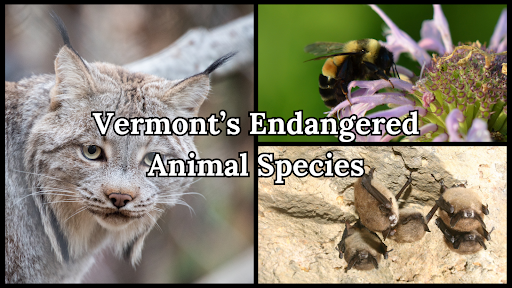The Wildlife Diversity Program of the Vermont Department of Fish and Wildlife oversees the Natural Heritage Inventory, the state’s official repository for records of endangered, threatened, and rare species. According to the most recent inventory in 2022, there are 53 animal species listed as endangered or threatened in Vermont: 37 state-endangered and 16 state-threatened. Seven of the 53 share a rather lamentable distinction — concurrently being listed under the federal Endangered Species Act (ESA): four endangered and three threatened.
The ESA establishes a federal framework to conserve and protect wildlife, fish, and plants designated as threatened or endangered. Passed over a half-century ago in 1973, it remains one of the most powerful and effective conservation acts in the United States.
To date, it is the only environmental legislation that doesn’t require a cost-benefit analysis before undergoing action.
So, while the seven species currently designated as endangered or threatened on both lists certainly don’t find themselves in an optimal situation, it’s not an entirely bleak one either.
The species receive the unique benefit of combined support from the ESA and Vermont’s state-specific wildlife resources. So keep reading to learn more about the origins and outlooks of a few threatened and endangered species listed under the Natural Heritage Inventory and Endangered Species Act.
Rusty Patched Bumble Bee
Photo Courtesy USFWS
The rusty patched bumble bee (Bombus affinis) is one of approximately 21 species found in the eastern U.S. The bee was added to the ESA as endangered in 2017 and retains the same status on Vermont’s list. Bumble bees live in colonies, and the rusty patched species likes to “go big or go home,” so to speak. Their full-sized colonies can grow to include more than one thousand workers alone.
Despite dwelling in various habitats, ranging from prairies and woodlands to marshes and residential parks, the species’ population has dropped rapidly since the turn of the century. The specific cause of this decline is yet to be determined, but prevailing theories and evidence suggest that harmful exposure to specific pesticides, namely insecticides and fungicides, is the driving culprit.
Habitat loss, competition with different bee species, and the effects of climate change are also cause for major concern.
The Vermont Fish & Wildlife Department (VFWD) partnered with the Vermont Center for Ecostudies and others to conduct a statewide survey of all native bees to address growing threats to the pollinators. The State of Vermont’s Wild Bees Report was the culmination of thousands of samples of data collected from more than 350 species of wild bees from 2019 to 2022.
On a federal level, the U.S. Fish and Wildlife Service (USFWS) finalized a rusty patched bumble bee recovery plan in 2021 and has been actively surveying, monitoring, researching, and managing habitats for the species ever since.
Canada Lynx
Photo Courtesy Eric Kilby
The Canada lynx (Lynx canadensis) is a medium-sized carnivorous cat — as in the cat family, which includes lions, tigers, and leopards, not just housecats — that was listed as threatened under the ESA in 2000 but holds an endangered status in Vermont’s state repository.
The species shares a striking resemblance to the most common cat native to North America: the bobcat. This rather uncanny similar appearance to the bobcat, also known as the wildcat, bay lynx, lynx cat, catamount, mountain lion, and a trove of other names, is largely because both animals belong to the Lynx genus.
The average Canada lynx adults weigh between 15 and 30 pounds and have large paws and long hind legs designed for hunting prey in deep and powdery snow.
The species mostly populates the boreal spruce-fir forest ecosystems or taigas found broadly across much of Alaska, Canada, and the northernmost continental U.S. states.
The lynx are quite reliant on their primary prey, the snowshoe hare, for survival and are commonly found wherever there are high populations of the hares. The cats have historically been decimated by hunting and fur trading and now face more modern threats related to habitat fragmentation from things like lumber.
In Vermont, there had been a growing consensus over the years that the animals were completely extirpated from the state. Despite countless false sightings that turned out to be — you guessed it — bobcats, a real Canada lynx was spotted in western Vermont for the first time in six years just a few weeks ago.
Brehan Furfey, whose last name is quite fitting for a biologist working at the VFWD, spoke about the promising sighting in a press release. “Vermonters can be proud that decades of land protection and management for connected habitats have allowed this rare wild cat to make its way through our state,” Furfey said.
Indiana Bat and Northern Long-Eared Bat
Photo Courtesy Al Hicks, NYDEC
The Indiana bat (Myotis sodalis) and northern long-eared bat (Myotis septentrionalis) are two species of cave bats designated as endangered in Vermont and under the ESA. However, they ended up there in entirely different ways.
The gray or brown-colored, pink-nosed Indiana bat is a small, insect-eating species that has been endangered since the establishment of the ESA itself. The extremely social bats hibernate in caves or mines during the wintertime. However, interestingly enough, they require forests — which provide opportunities to roost and forage — to survive.
Typically colored with brown fur, northern long-eared bats distinguish themselves with distinct, long ears.
Similarly to the Indiana bats, they also dine on insects, hibernate in caves or mines in the winter, and occupy forests the remainder of the year.
Unlike its state-named counterpart, the long-eared bat species is quite a recent addition to the ESA, and the reason is the largest threat to most cave-based bats today. In 2022, the USFWS reclassified the bats from threatened to endangered due to an unprecedented decline in population levels from white-nose syndrome.
As of 2019, the population of Indiana bats in the U.S. was estimated at 537,297 — roughly half the size of when the species was first listed on the ESA in 1973. However, since the arrival of white-nose syndrome in North America in 2007, the population has declined by 19%.
The wildlife disease is considered one of the worst in modern times, killing millions of bats in North America alone. Caused by Pseudogymnoascus destructans, a fungus that can resemble white powder or fuzz on a bat’s face, white-nose syndrome affects hibernating bats like the Indiana and northern long-eared species.
While there is no cure, researchers and scientists in Vermont, the U.S., and the rest of the world are collaborating to create one and have developed several experimental vaccines and other treatments. Plus, the project is looking for volunteers across North America. You can get involved or learn more about the efforts at the White-nose Syndrome Response Team website.





